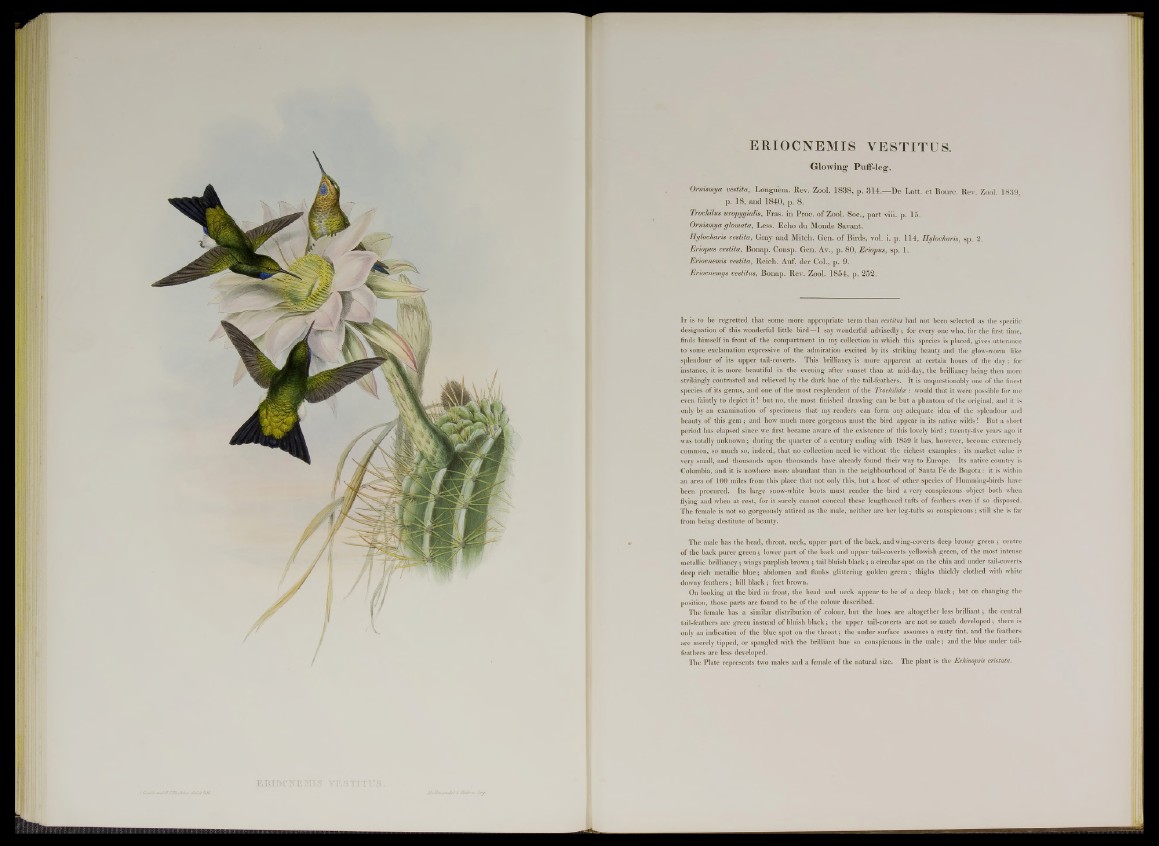
ERIOCNEMIS VESTITUS.
Glowing’ Puff-leg*.
Ornismya vestita, Longuem. Rev. Zool. 1838, p. 314.—De L a tt. e t Bourc. Rev. Zool. 1839,
p. 18, and 1840, p. 8.
Trochilus uropygialis, Fras. in Proe. o f Zool. Soc., p a rt viii. p. 15.
Ornismya giornata, Less. Echo du Monde Savant.
Hylocliari» vestita, Gray and Mitch. Gen. o f B irds, vol. i. p. 114, Hylocharis, sp. 2.
Eno p u s vestita, Bonap. Consp. Gen. Av., p. 80, Enopus, sp. 1.
Eriocnemis vestita, Reich. Auf. der Col., p. 9.
Eriocnemys vestitus, Bonap. Rev. Zool. 1854, p. 252.
It is to be regretted that some more appropriate term than vestitus had not been selected as the specific
designation of this wonderful little bird—I say wonderful advisedly; for every one who, for the first time,
finds himself in front of the compartment in my collection in which this species is placed, gives utterance
to some exclamation expressive of the admiration excited by its striking beauty and the glow-worm like
splendour of its upper tail-coverts. This brilliancy is more apparent at certain hours of the day; for
instance, it is more beautiful in the evening after sunset than at mid-day, the brilliancy being then more
strikingly contrasted and relieved by the dark hue of the tail-feathers. It is unquestionably one of the finest
species of its genus, and one of the most resplendent of the Trochilidte : would that it were possible for me
even faintly to depict i t ! but no, the most finished drawing can be but a phantom of the original, and it is
only by an examination of specimens that my readers can form any adequate idea of the splendour and
beauty of this gem; and how much more gorgeous must the bird appear in its native wilds! But a short
period has elapsed since we first became aware of the existence of this lovely bird; twenty-five years ago it
was totally unknown; during the quarter of a century ending with 1859 it has, however, become extremely
common, so much so, indeed, that no collection need be without the richest examplesjjsjts market value is
very small, and thousands upon thousands have already found their way to Europe. Its native country is
Columbia, and it is nowhere more abundant than in the neighbourhood of Santa Fe de Bogota: it is within
an area of 100 miles from this place that not only this, but a host of other species of Humming-birds have
been procured. Its large snow-white boots must render the bird a very conspicuous object both when
flying and when at rest, for it surely cannot conceal these lengthened tufts of feathers even if so disposed.
The female is not so gorgeously attired as the male, neither are her leg-tufts so conspicuous; still she is far
from being destitute of beauty.
The male has the head, throat, neck, upper part of the back, and wing-coverts deep bronzy green ; centre
of the back purer green; lower part of the back and upper tail-coverts yellowish green, of the most intense
metallic brilliancy; wings purplish brown; tail bluish black; a circular spot on the chin and under tail-coverts
deep rich metallic blue; abdomen and flanks glittering golden green; thighs thickly clothed with white
downy feathers; bill black ; feet brown.
On looking at the bird in front, the head and neck appear to be of a deep black; but on changing the
position, those parts are found to be of the colour described.
The female has a similar distribution of colour, but the hues are altogether less brilliant; the central
tail-feathers are green instead of bluish black; the upper tail-coverts are not so much developed; there is
only an indication of the blue spot on the throat; the under surface assumes a rusty tint, and the feathers
are merely tipped, or spangled with the brilliant hue so conspicuous in the male; and the blue under tail-
feathers are less developed.
The Plate represents two males and a female of the natural size. The plant is the Echinopsis cristata.